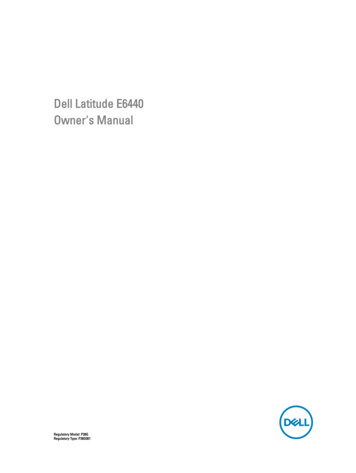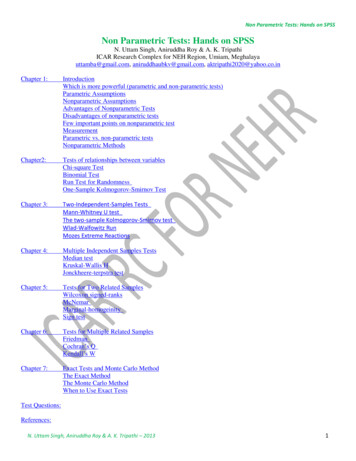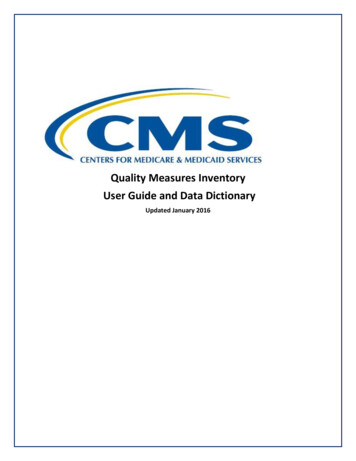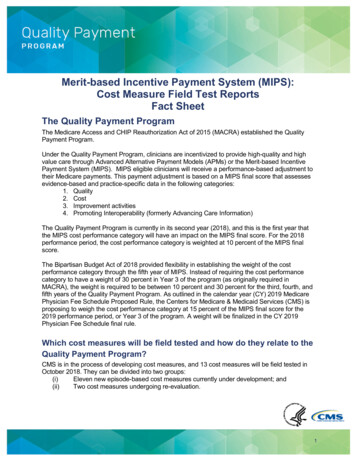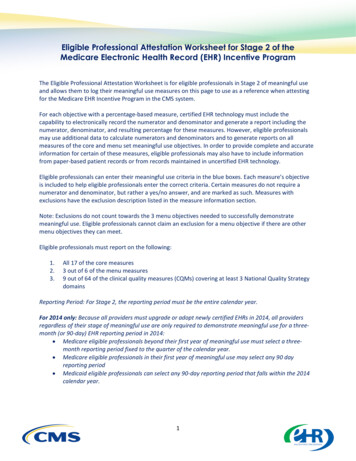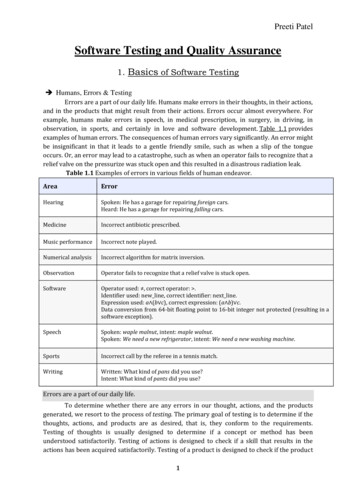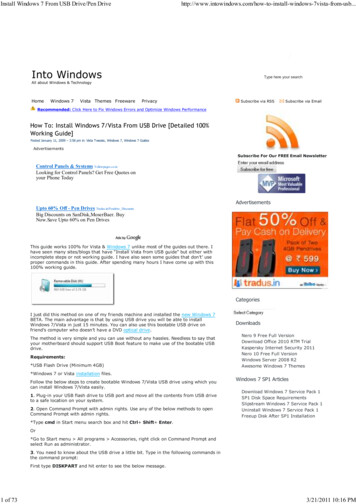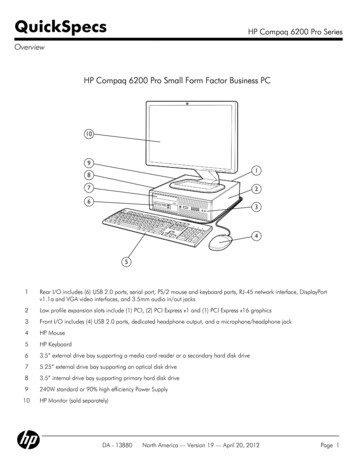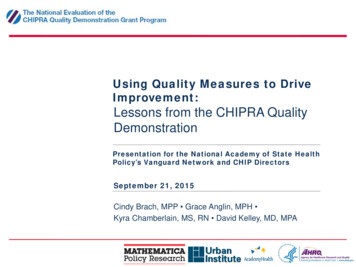
Transcription
Using Quality Measures to DriveImprovement:Lessons from the CHIPRA QualityDemonstrationPresentation for the National Academy of State HealthPolicy’s Vanguard Network and CHIP DirectorsSeptember 21, 2015Cindy Brach, MPP Grace Anglin, MPH Kyra Chamberlain, MS, RN David Kelley, MD, MPA
Agenda Welcome and introductions– Cindy Brach, MPP, Senior Health Policy Researcher, Agency for HealthcareResearch and Quality Overview of states’ strategies and lessons learned– Grace Anglin, MPH, Researcher, Mathematica Policy Research Inc. Maine’s approach– Kyra Chamberlain, MS, RN, CHIPRA Project Director, University of Southern Maine Pennsylvania's approach– David Kelley, MD, MPA, Chief Medical Officer, Pennsylvania Department of PublicWelfare Q&A session2
Housekeeping Please mute your phone Do not put us on hold; hang up and dial back in if youneed to take another call Ask questions– Submit questions throughout the presentation via the chatfeature– During the Q&A, feel free to jump in with questions or “raiseyour hand”3
Overview of States’ Strategies andLessons Learned4
CHIPRA Quality Demonstration Program Congressionally mandated in 2009– 100 million program– One of the largest federal efforts to focus on child health care Five-year grants awarded by CMS– February 2010 - February 2015, with some extensions– 6 grants: Multi-state partnerships National evaluation– CMS funding, AHRQ oversight– August 2010 – September 2015– Mathematica, Urban Institute, AcademyHealth5
Demonstration grantees* and partnering statesimplemented 52 projects across 5 topic areas6
States’ Quality Measure and Reporting StrategiesCalculatemeasuresUse measuresto drive QIImprovequality of care Report results to stakeholders Align QI priorities Support provider-level improvement7
Reporting Results to Stakeholders Goals– Document and be transparent about performance– Allow comparisons across states, regions, and health plans– Identify QI priorities and track improvement over time CHIPRA state strategies– Produce reports from various sources Administrative data (Medicaid claims, immunization registries) Practice data (manual chart reviews, EHRs)– Develop reports for different audiences: policymakers, health plans,providers, public8
Reporting Results to Stakeholders Lessons learned– Seek feedback from intended audience during design phase– Short reports that use graphics to display information are easier todigest– Budget adequate resources to adjust specifications for practice-levelreporting“Measure reports [have] been useful for disseminating information about what’sgoing on and what needs to be worked on. [Performance on] all of the measureshasn’t been great, so bringing awareness to those areas has been a greatopportunity for the State.”—Florida Demonstration Staff9
Aligning QI Priorities Goals– Foster system-level reflection– Set the stage for collective action– Create a powerful incentive for providers to improve care CHIPRA state strategies– Formed multistakeholder quality improvement workgroups– Encouraged consistent quality reporting standards across programs– Required managed care organizations to meet quality benchmarks10
Aligning QI Priorities Lessons learned– Familiarizing stakeholders with the measures and gaining consensuson priorities sometimes proved challenging– Focusing discussions and reports on state priorities and contexthelped facilitate conversations– Several factors influenced QI priorities Measure alignment with existing initiatives and prioritiesRoom for improvementData qualityCost and burden of tracking performance11
Supporting Provider-Level Improvement Goals– Help providers interpret quality reports and track performance– Help providers identify QI priorities and design QI activities– Encourage behavior change and use of evidence-based practicesamong providers CHIPRA state strategies– Technical support Hosted learning collaboratives Provided individualized technical assistance– Financial support Provided stipends or embedded staff Paid providers for reporting measures and demonstrating improvement Changed reimbursement to support improvements12
Supporting Provider Improvement Lessons learned– Disappointing initial results were common; may have reflectedperformance and/or documentation– State-produced reports are helpful for identifying QI priorities butless useful for guiding and assessing QI projects Long delays in claims processing Infrequent reporting periods– Helping practices run reports from their charts or EHRs providedthem more real time information to track QI efforts“Getting feedback from someone outside [of the practice] is really the only wayyou can improve . . . When it comes to ourselves, we have tunnel vision.”— North Carolina Practice Manager13
Supporting Provider Improvement Lessons learned– Several factors encouraged providers to make and sustainmeaningful changes Choosing their own QI topicsFocusing on one or just a few measures at a timeEngaging the entire care team in reviewing measures and planning changesFostering a healthy rivalry between providersReceiving reimbursement for related services“Everybody has to understand that change is not one person’s job, it isthe practice’s job.”— South Carolina Physician14
Maine's Approach:Using Multistakeholder Groups to EngagePolicymakers and Practices15
Project Context Measurement work of Maine’s CHIPRA Grant built off longstandingcooperative agreement between Maine DHHS and University ofSouthern Maine’s Muskie School of Public Service– Technical assistance and data analytic support using longitudinal data warehouse– Program evaluation and monitoring for Maine’s Medicaid program– Calculating CMS-416 measures and producing periodic, practice-level Utilization Reviewand Primary Care Performance Incentive Program (PCPIP) reports CHIPRA supported the collaboration of health systems, providers, Stateagencies, non-profit groups, and consumers to build an infrastructurefor meaningful and robust child health quality measurement16
Project Overview Original multi-stakeholder Measures and Practice ImprovementCommittee formed to explore and obtain feedback on child healthquality measures Maine Child Health Improvement Partnership formed to identify andcoordinate efforts to use measures to drive quality improvement– Workgroup structure Comprised of health systems, practices, child advocacy organizations,professional associations, public and private payers, and the public health system Met every 6 months– CHIPRA activities Developed and periodically revised Master List of Pediatric Measures Disseminated annual reports on statewide performance on child-focusedmeasures Encouraged measure alignment Identified QI priorities and potential solutions17
Project Overview Supported the Maine Child Health Improvement Partnership– Member of the National Improvement Partnership Network– Mission is to initiate and support measurement-based activities toenhance child health care improvement– CHIPRA activities Hosted 3 rounds of 9-month learning collaboratives to improve performance onmeasures related to immunizations, developmental screening, oral health, andhealthy weight Advised Maine’s public reporting program on child-health priorities and measures18
Project Outputs Increased monitoring of child-focused measures Changed billing policies to support quality improvement– PCPs can bill for oral health evaluations– Relaxed frequency providers can bill for oral health evaluations– New billing modifier distinguishes between global developmentaland autism screenings Engaged 12-34 practices in each learning collaborative– Practices demonstrated improvements, most notably on developmental screening andimmunizations19
Project OutcomesIncreases in developmental screening ratesfor practices participating in Maine’s developmentalscreening learning -12 months(n 7)18-23 months(n 9)May-1224-35 months(n 9)Nov-12Note: Maine analyzed data for participating practices that submitted chartdata for review.20
Project OutcomesChanges in standardized screenings for developmental,behavioral, and social delays for all children enrolled inMedicaid and CHIP30%26%25%19%20%15%17%13%12% 12%10%5%6%2% 3%3%1% 2%0%Birth to 1 year20111 to 2 years20122120132 to 3 years2014
Project OutcomesIncreases in immunization rates for practices participating in Maine’s First STEPSPhase 1 learning collaborative from August 2011 to November 201322
Lessons Learned Statewide improvement on quality measures required:– Broad stakeholder involvement– Variety of strategies Broad stakeholder involvement in priority-setting increased buy in forQI activities Changes in quality measures may reflect:– Improvements in quality of care– Improvements in documentation and billing of services Billing changes or clarifications improved data quality and encouragedpractice change23
Lessons Learned Measures to assess practice QI activities were selected based on: Relevance to the QI topic and project objectives Availability of baseline data Feasibility of reliably collecting data Providers must trust and understand data to use it for QI Explain differences in measure specifications and rate calculations Educate practices on how and when to use each type of data or quality measure Help practices read, interpret, and use practice-level reports for QI efforts Piloting changes with a subset of practices led to statewide changes Statewide rates for developmental screening continued to rise after 2011 Maine rose from #16 to #1 nationally for 2 Year Old Vaccine Rates (NIS 2014)24
Pennsylvania's Approach:Paying providers for reporting measures anddemonstrating improvement25
Pennsylvania Medical Assistance Mandatory managed care Over 1.1 million children covered by Medicaid Managed Care Organizations reporting both HEDIS and PennsylvaniaPerformance measures Quality measures and consumer report card published althchoicespublications/ Over 5,800 providers participating in Medicaid Meaningful Useelectronic health record (EHR) program CHIPRA grantees included five high volume pediatric serving healthsystems, one small rural health system, and a FQHC Grantees were at widely different phases of EHR implementation26
Project Overview Two health systems worked with PA Department of Human Services toestablish process of extraction and reporting of quality measures Based on a standardized process, five other provider organizationsreported measures annually to PA Measures had to be reported directly from the provider organization’sEHRPerformanceyearRequirement Payment levelfor paymentAnnual capQualifyingmeasuresBase yearReporting 10,000 permeasure 180,000 perproviderAny Child CoreSet measureSubsequentyearsDemonstrateimprovement 5,000 perpercentage pointimprovement 25,000 permeasure; 100,000 perprovider8 high prioritymeasures27
Project OverviewHigh priority measuresChildhood immunization statusAdolescent immunization statusWell-child visits in the first 15 months Well-child visits in the 3rd, 4th, 5th,of lifeand 6th years of lifeDevelopmental screening in the first3 years of lifeAdolescent well-care visitPercentage of eligibles that receivedpreventive dental servicesWeight assessment and counselingfor nutrition and physical activity forchildren/adolescents: Body massindex assessment for children/adolescents28
Project Outcomes PA paid 935,000 in incentive payments, ranging from 65,000 to 260,000 per provider organization Participating provider organizations– Reported on 10 to 18 Child Core Set Measures– Demonstrated improvement on measures Childhood immunization statusBody mass index assessmentWell-child visitsDental preventive care Providers were engaged in quality reporting and QI29
Project OutcomesPay for Performance MeasureAverage rate of improvementacross evelopmental screening in the firstthree years of life13.8%Body Mass Index Assessment5.0%Well Child VisitsFirst fifteen months of life8.65%Children aged 3-6 years5.0%Adolescents3.5%Preventive dental services10.2%30
Project Outcomes%Child-serving Physicians' Reported Experiences withand Attitudes Toward Quality 442.2Generated internalquality reports*Felt quality reports are Quality improvementeffective*effort in last 2 yearsPhysicians in participating health systems (n 52)Physicians outside participating health systems (n 178)* statistically significant difference (p 0.05)Source: Survey of child-serving physicians31
Lessons Learned Providers pursued a range of tactics to improve quality of care– Scheduling the next well-child visit before a patient leaves the office from thecurrent visit– Placing automated reminder calls to parents– Providing parents with contact information for local dentists Provider organizations supplemented annual reporting to PA to driveclinician-level change– Produced measures monthly or quarterly– Developed clinician-level (in addition to organization-level) reports32
Lessons Learned Provider organizations using EHRs with advanced reportingcapabiltities were able to report more measures– Programming EHRs to extract and report quality measures can be time andresource intensive– Using internal clinical and information technology staff to program measuresresulted in measures that more accurately reflected actual performance33
Q&A34
For More Information Visit the National Evaluation website– ndex.html Contact the speakers––––Cindy Brach (Cindy.Brach@ahrq.hhs.gov)Grace Anglin (GAnglin@mathematica-mpr.com)Kyra Chamberlain (kyra.chamberlain@maine.edu)David Kelley (c-dakelley@pa.gov)35
Policy's Vanguard Network and CHIP Directors . Lessons from the CHIPRA Quality Demonstration . Cindy Brach, MPP Grace Anglin, MPH Kyra Chamberlain, MS, RN David Kelley, MD, MPA . September 21, 2015 . 2 Agenda Welcome and introductions - Cindy Brach, MPP, Senior Health Policy Researcher, Agency for Healthcare Research and Quality Overview of states' strategies and .

